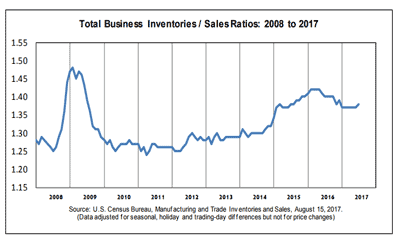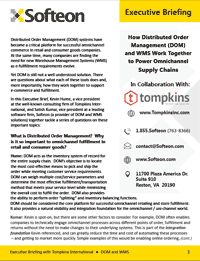Supply Chain Inventory Performance 2017
Since 2005, I have been doing reporting and analysis on company and sector inventory levels based on the annual Working Capital scorecard that is compiled by The Hackett Group.
It is always one of our most popular columns of the year.
But there have been a few twists over the years, and another one this year, as I am going to explain here.
| SHERMAN SAYS: |
Some categories (e.g., department stores) are pretty homogeneous - others have more variance between company business models within a category.
WHAT DO YOU SAY?
Send us your
Feedback here
|
This data sent to me comes from Hackett's overall analysis of working capital performance for the 1000 largest publicly traded US companies. That means the full report and data set looks at three components of working capital, changes in which of course then directly determine overall cash flow, Days Sales Outstanding (DSO), Days Inventory Outstanding (DIO), and Days Payables Outstanding (DPO). Here, we are going to focus on just the inventory component.
Until two years ago, Hackett calculated DIO relative to how many days of sales a company held in inventory. That generated many complaints from readers, as the divisor in the formula was a day's worth of revenue, not a day's worth of cost of goods sold, as is typically how it is measured. As I said each year, that's how Hackett reported the data, and that's how thus I had to deal with it.
Also frustrating was that you cannot directly convert DIO to inventory turns using that approach because each company's gross margin percent is different. If you are measuring inventory turns using cost of goods sold in the equation, you can't derive that turns number if you calculated DIO based on a day's sales instead of COGS.
But starting with the data for 2014, the Hackett DIO calculation was changed to:
DIO = End of Year Inventory Level/[Total Cost of Goods Sold/365]
So, you calculate the average cost of goods sold for one day, and then see how many of those COGS days you keep in inventory (based on year-end balance sheet numbers).
As such, DIO is sort of the reverse of inventory turns, in that a higher DIO, all things being equal, means poorer inventory management performance, while a lower number signals improvement. You are being more efficient with inventory versus a given level of COGS.
So, let's take 3M. In 2016, it ended the year with COGS equal to $15.04 billion, and inventory levels of $3.335 billion. So its DIO is:
3,335,000,000/[15,040,000,000/365] = DIO of 82.1 Days
That DIO compares to inventory turns of:
15,040,000,000/3,335,000,000 = 4.4 Turns
Clear as mud?
Now, I usually get the data from Hackett in late July and do all the segmenting and analysis (more on that in a second) to produce my columns in early August. But this year, for reasons I won't get into, Hackett was not able to send the data until a couple of weeks ago.
So when I finally took a look, the companies in many sectors had somehow been cut back. Which takes me to me next point: the big value-add SCDigest has performed is to re-sort individual companies into new categories, so the categories and comparisons in our view are more usable for supply chain thinking. For example, in the original Hackett data, home builders like Toll Brothers are mixed in the household durables category with companies like Whirlpool. That is one of the most blatant "apples and oranges" combinations, but there were a number of others that don't jive, at least from a supply chain perspective. Metal producers such as US Steel were in the same category as miners, while "spirits" beverage companies were in the same category as soft drink companies, when the inventory dynamics of each group are dramatically different, in two of many other examples.
So, we did the (really) hard work of first eliminating sectors that aren't useful for the supply chain (e.g., bankers, etc.), and then redefining and populating the categories in a way that makes more sense for comparisons. As another example, rather than having one giant category of all specialty retail, we break that down into apparel, department stores, auto parts, etc. It really does take a lot of time.
It is far from perfect. Should Johnson & Johnson be placed in the pharma group, the medical device category, or consumer packaged goods, as it is in all those segments? Is Honeywell in the aerospace or automotive sector, or one of the "industrial conglomerates" like GE or 3M? That's where we put it again this year. There are many such examples where the call is not obvious.
In the end, we simply make choices, including looking up more details on a number of companies with which we were not familiar so they could be placed appropriately. This is in fact very difficult: how do you segment the dozens of public companies that are in the general “machinery” category? Should just Ford, GM and Tesla be together in a small auto OEM group, or should we broaden the category and mix those companies say with freight truck manufacturers such as Navistar and PACCAR, along with motorcycle maker Harley-Davidson? (That's what we did).
So, category construction and comparisons are fraught with issues and questions, but we do the best that we can. Some categories (e.g., department stores) are pretty homogeneous - others have more variance between company business models within a category.
The other thing we've done in the past is add in companies that for whatever reason were left out of the Hackett data set, based on a manual data look-up. Mysteriously, for example, retail giant Lowes was left out of the data every year.
So to net it all out, given changes to the Hackett data, we developed a tool to pull numbers from sites like Google or Yahoo Finance, and then applied that data to the categories and companies we built last year.
First, I will note again that I am struck by the impact mergers and acquisitions on shrinking the list - there are simply fewer companies out there. This will be the last year both Dow and DuPont are on the list, as that merger of chemical giants is just now complete. Johnson Controls recently swallowed up Tyco. We now have Kraft Heinz, which tried and failed to take over fellow CPG giant Unilever earlier this year after their merger.
It never ends - with impacts on the supply chain in many ways. I don't think it is good.
Across the 554 companies we annualized, average inventory turns in 2016 were 8.94. That compares with 8.48 in 2013 - or an improvement of about 5% over the last four years. That's actually not bad- but many companies and sectors went nowhere or backwards since 2013. BTW, that 8.94 turns equates to a DIO of 40.8. As a check, the annual WERC DC metrics data found median DIO of 45, based on survey data.
That's consistent with data on the US "inventory to sales" ratio (inventory levels divided by a month's worth of sales) from the Commerce Dept. As shown below, in late 2008/early 2009 the measure spiked as the recession caught companies with way more inventory than needed versus suddenly shrinking demand. But most companies cut away at that inventory ruthlessly, so that inventory was back on the longer term downward trend line by early 2010.
|



![]()
![]()

![]()











